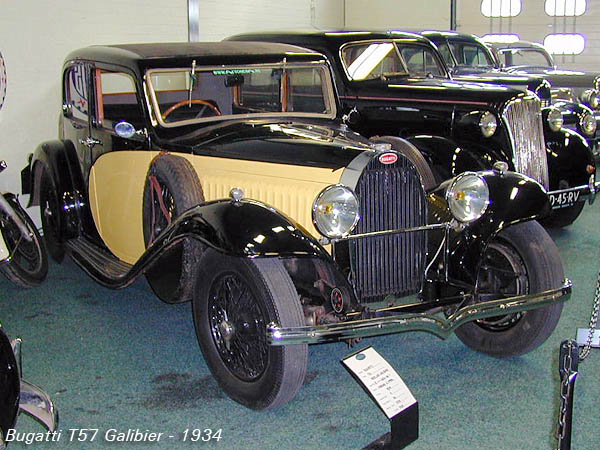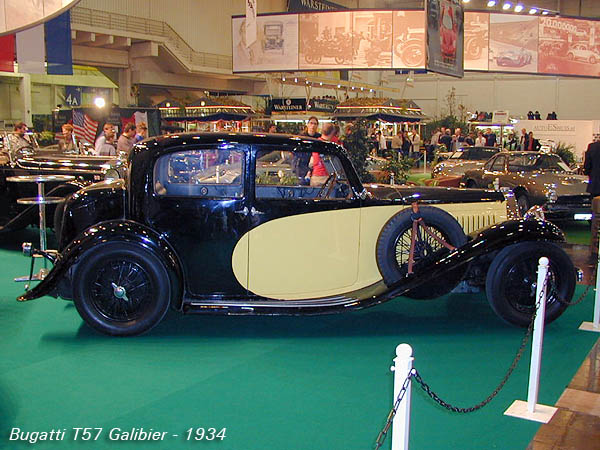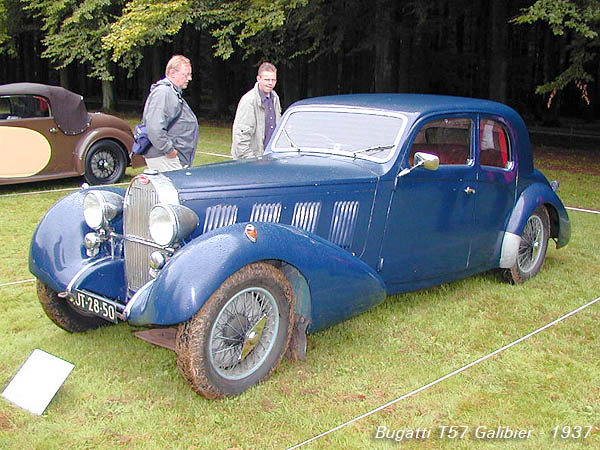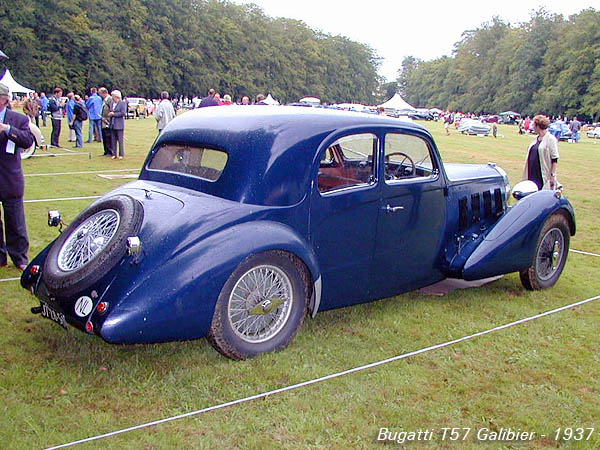The Galibier was named after a mountain pass on the French side of the Alps. It was the most sedate model within the Type 57 range, a 4-door 4-seater sedan with conservative looks in the Bugatti tradition. With the coach Ventoux and cabriolet Stelvio the berline Galibier formed the backbone of the Type 57 range and was made in three consecutive series. This body style was only available on the standard chassis.
 The first series, like you see here, appeared even rather old fashioned, quite a contrast to the rest of the range. Distinctive features of the Galibier were the lack of doorpillars between the front and rear doors, which opened in opposite directions to create a very wide entrance, and the separate trunk at the back. In front there were the thermostatically operated radiator blinds, standard for all Type 57 cars. The first series, like you see here, appeared even rather old fashioned, quite a contrast to the rest of the range. Distinctive features of the Galibier were the lack of doorpillars between the front and rear doors, which opened in opposite directions to create a very wide entrance, and the separate trunk at the back. In front there were the thermostatically operated radiator blinds, standard for all Type 57 cars.
The Type 57 models were modernized over the years; the first series can be identified by long vertical louvres on the sides of the bonnet and separately mounted headlights amongst other things. The second series, like shown above, had several horizontal rows of smaller vertical louvres on the sides of the bonnet while the third series often had horizontal louvres in vertical rows on the sides of the bonnet and headlights faired into the front wings. Of course Bugatti built many of these cars to order so these characteristics do not always apply, depending on the wishes of the customer.
 The Galibier sedan was one of the first models to appear on the Type 57 chassis in 1934. The first series of the Type 57 ran from 1934 till 1936 and showed a remarkable combination of advanced engineering and conservative solutions. Advanced were the extensive use of aluminum, the double-overhead camshafts on the engine, the crank with 6 (friction) bearings, a dry single plate clutch and a 4-speed gearbox integrated with the bell-house of the engine with the top 3 speeds synchronized. Very conservative however were the solid front and rear axles, the elliptical springs and, certainly for such a powerful car, the cable operated drum brakes. The Galibier sedan was one of the first models to appear on the Type 57 chassis in 1934. The first series of the Type 57 ran from 1934 till 1936 and showed a remarkable combination of advanced engineering and conservative solutions. Advanced were the extensive use of aluminum, the double-overhead camshafts on the engine, the crank with 6 (friction) bearings, a dry single plate clutch and a 4-speed gearbox integrated with the bell-house of the engine with the top 3 speeds synchronized. Very conservative however were the solid front and rear axles, the elliptical springs and, certainly for such a powerful car, the cable operated drum brakes.
 Later Galibier models looked more modern with skirted fenders, integrated trunk and more flowing lines in general. The body of this Galibier wasn't built in France but in Switzerland by coach builder Graber. External coach builders however often followed the style of the original Bugatti designs. Later Galibier models looked more modern with skirted fenders, integrated trunk and more flowing lines in general. The body of this Galibier wasn't built in France but in Switzerland by coach builder Graber. External coach builders however often followed the style of the original Bugatti designs.
Special on this sedan body is the arrangement of the doors. Like at the car above there are no doorpillars but the rear doors lack separate doorhandles. The rear doors are unlocked with the front doors, which seems impractical. This was probably done to make it look like a more sporting 2-door coupe.
 The second series of the Type 57 ran from 1937 till 1938 and showed a number of changes: the engine was now mounted in rubber to silence vibrations; the camshafts, valve guides, crank casing and exhaust manifolds were improved and adapted for mounting a (Roots) compressor; the chassis was reinforced and the dashboard instruments were elaborated. Galibiers appeared even more modern during the late 1930s with fastback and streamlined styling and front and rear doors hinged on doorpillars, where the front doors opened backwards (so-called "suicide doors"). The second series of the Type 57 ran from 1937 till 1938 and showed a number of changes: the engine was now mounted in rubber to silence vibrations; the camshafts, valve guides, crank casing and exhaust manifolds were improved and adapted for mounting a (Roots) compressor; the chassis was reinforced and the dashboard instruments were elaborated. Galibiers appeared even more modern during the late 1930s with fastback and streamlined styling and front and rear doors hinged on doorpillars, where the front doors opened backwards (so-called "suicide doors").
The Galibier was available until 1940 but wasn't a very popular choice within the Type 57 range. Quite a few are still extant today but a Galibier remains a rare sight even for Bugatti standards.
|
